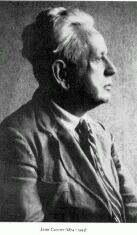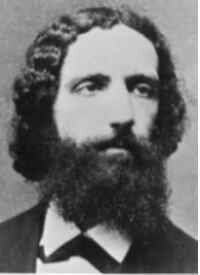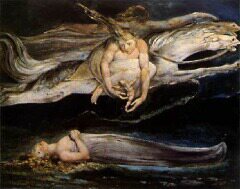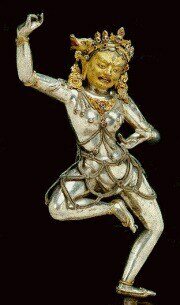 Thinkers committed
to transformative practice are likely to exhibit
at least as peculiar 'forms of life' as found in any of the later Wittgenstein's
'language games'.
Nietzsche's as well as
Steiner's practices foreshadow the movement of thinking in
our
era to uncover Time as thinking's proper element. And because their
practices bring time together in life, and because
life
realizes time with evidence that makes thought pale, we must
interpret these two on the basis of their lives and not only what
we find in the pictures they offer.
Thinkers committed
to transformative practice are likely to exhibit
at least as peculiar 'forms of life' as found in any of the later Wittgenstein's
'language games'.
Nietzsche's as well as
Steiner's practices foreshadow the movement of thinking in
our
era to uncover Time as thinking's proper element. And because their
practices bring time together in life, and because
life
realizes time with evidence that makes thought pale, we must
interpret these two on the basis of their lives and not only what
we find in the pictures they offer.
VI(c) |
|
New
foundations for meaning: myth
uncovers metaphor as meaning's deepest roots and as the basis of
thinking's openness to the past. Religion's way of
conjoining presence, future and past as opennesses.
|
 Thinkers committed
to transformative practice are likely to exhibit
at least as peculiar 'forms of life' as found in any of the later Wittgenstein's
'language games'.
Nietzsche's as well as
Steiner's practices foreshadow the movement of thinking in
our
era to uncover Time as thinking's proper element. And because their
practices bring time together in life, and because
life
realizes time with evidence that makes thought pale, we must
interpret these two on the basis of their lives and not only what
we find in the pictures they offer. Thinkers committed
to transformative practice are likely to exhibit
at least as peculiar 'forms of life' as found in any of the later Wittgenstein's
'language games'.
Nietzsche's as well as
Steiner's practices foreshadow the movement of thinking in
our
era to uncover Time as thinking's proper element. And because their
practices bring time together in life, and because
life
realizes time with evidence that makes thought pale, we must
interpret these two on the basis of their lives and not only what
we find in the pictures they offer. |
|
Though
Nietzsche tilted at the windmill of the future, his knightly
armour sparkled and creaked with his own time's apparatus of the
sciences, even while a great deal of his challenge unfurled to
pointedly mock the history of 'civilized institutions'.
|
|
The
Anti-Christ
titles one of Nietzsche's later works. |
 Madame Blavatsky and Anne Besant were chief Theosophists, the movement in which Steiner found followers and from which he broke away. |
 |
Steiner
never admitted that suicidal narrowing into national identity as
his land's fate accompli; he found sufficient diversity and
aptitude for what he tried to teach as 'supersensible perception'
among the people who sought him out, to dedicate his life to them.
Steiner made use of the cultural potencies at hand to give his
practice social effect. So unless we can begin to recognize the
scope of Steiner's intentions, the means he brought to bear might
make his work seem nearly antithetical to the advance of thinking,
might even suggest that he was involved in a confused (and
confusing) conglomeration of atavisms.
|
| Steiner's
The
Education of the Child is
one place to learn more. Also the beautiful Education
Toward
Freedom, text: Frans Carlgren. layout: Arne
Klingborg,
Lanthorn Press. And recently, the delightful Natural
Childhood,
John
Thomson, ed., Simon and Schuster |
As a 'renegade', a thinker
involved in
transformative practice,
Steiner leaves us no culminating type of synthesis which can
picture us the order and value of his thought, though anyone who
observes a healthy Waldorf school might have from Steiner something
better than such a picture. Here is one way Steiner has sent
himself toward the future - through the children as a favor to
them. One wonders what it says about our time that such a result of
thinking could remain so little acknowledged for so long.
|
|
The amorphousness of Steiner's
legacy is compounded not only by the
instrumentalities of its dissemination in his time and additionally
its mediations in our own, but also by the nature of the direction
in which he was fundamentally turned. Steiner surely stood at the
other end of the boat from
Whitehead and
Nietzsche as it crossed into the twentieth century, looking
not
toward the unknown land looming in advance but into the homeland
vanishing aft.
|
|
Steiner's work, like Dilthey's and Husserl's in its prodigiality, embodies a response to the Romantic position that Mind's foundations and its capacity for truth belong first to Mind's productivity - to use Goethe's word in Faust, its deeds.  |
Steiner's six-thousand-odd
transcribed lectures are mostly staged on the basis of what most
thinkers would take as mythological content, and within those
lectures Steiner works to call forth apprehensions whose meanings
employ such 'mythic' frames of reference. Even by late
nineteenth century standards, when the study of myth seemed to be
of preeminent importance for coming to terms with the origins and
destiny of humanity, Steiner's approach constituted the breaking of
taboos for many of the thinkers of his time. Not just because he
could be seen as the focus of a 'cult', but even more because
instead of using myth as a subject for conceptual analysis, he
asked for a kind of participation in typically mythic distinctions
which could not be reduced to objectifying relations: Steiner said that he meant to teach Imagination,
Inspiration, and Intuition. These words
signified
faculties offering insights and relations in reality which were not
susceptible to capture in externalizable ideas. Their truth was
characterized as a function of the concrete reality whose gathering
together constituted their occasion. Such truths belong to their
moments as incarnations for awareness and can not be well used as
building blocks for systems of concepts.
|
|
|
But how is it
this
lives in
thy mind?
What seest thou else in the dark backward and abyss of time? |












